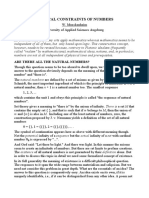0 ratings0% found this document useful (0 votes)
97 viewsBinary Decimal Radix
The document provides two methods for converting a binary fraction to a decimal number. The first method involves multiplying each binary digit by its place value as a decimal fraction and adding the results. The second method shifts the radix point to the end of the binary number, converts the resulting integer to decimal, and divides the result by two raised to the power of the number of places shifted. An example is worked out using both methods to convert the binary fraction 0.1101 to the decimal number 0.8125.
Uploaded by
rhixrojasCopyright
© Attribution Non-Commercial (BY-NC)
Available Formats
Download as DOC, PDF, TXT or read online on Scribd
0 ratings0% found this document useful (0 votes)
97 viewsBinary Decimal Radix
The document provides two methods for converting a binary fraction to a decimal number. The first method involves multiplying each binary digit by its place value as a decimal fraction and adding the results. The second method shifts the radix point to the end of the binary number, converts the resulting integer to decimal, and divides the result by two raised to the power of the number of places shifted. An example is worked out using both methods to convert the binary fraction 0.1101 to the decimal number 0.8125.
Uploaded by
rhixrojasCopyright
© Attribution Non-Commercial (BY-NC)
Available Formats
Download as DOC, PDF, TXT or read online on Scribd
You are on page 1/ 1
it has a lot of information on converting both integers and fractions
to other bases. But I didn't see an example of converting a fraction
FROM binary back TO decimal, so here are the methods and an example.
The place values to the right of the radix point (what we call the
equivalent of the "decimal point" when working in other bases) are
simply negative powers of two:
[.] 2^(-1) 2^(-2) 2^(3) 2^(-4) ...
When a base is raised to a negative power, it just means the
reciprocal of the base raised to that (positive) power. For example,
2^(-1) = 1/(2^1) = 1/2, and 2^(-2) = 1/(2^2) = 4, etc. So the place
values can also be expressed as:
[.] 1/2 1/4 1/8 1/16 ...
Of course, we can also express these fractions in decimal form as:
[.] .5 .25 .125 .0625 ...
So the binary fraction 0.1101 represents:
1/2 1/4 1/8 1/16
--- --- --- ----
. 1 1 0 1
Just as with integers, we multiply each digit by its place value and
add the results. For my example, we'd get:
1 * 1/2 = 1/2 = 8/16 1 * .5 = .5
+ 0 * 1/4 = 1/4 = 0/16 1 * .25 = .25
+ 1 * 1/8 = 0 = 2/16 or + 0 * .125 = .0
+ 1 * 1/16 = 1/16 = 1/16 1 * .0625 = .0625
----- -----
11/16 .8125
As an alternate method, you can simply move the radix point to the
right end of the number (as long as it's not a repeating fraction).
Count how many places you moved the radix point. Convert the resulting
integer to binary, and divide by 2^n, where n is the number of places
you moved the radix point.
In my example, we can convert .1101 to decimal by:
.1101
1. Shift the radix point to the right end 1101.
2. Count the number of places moved (4 places)
3. Convert the integer to decimal 1101_2 = 13_10
4. Divide the result by 2^n 13/(2^4) =
13/16 =
.8125
I hope this helps. If you have any more questions, write back.
You might also like
- Appendix F: Numbers in Binary, Octal, and Hexadecimal RepresentationsNo ratings yetAppendix F: Numbers in Binary, Octal, and Hexadecimal Representations4 pages
- Business Mathematics Summary of Lessons 1No ratings yetBusiness Mathematics Summary of Lessons 18 pages
- Changing Improper Fractions To Mixed NumbersNo ratings yetChanging Improper Fractions To Mixed Numbers6 pages
- Binary and Hexidecimal Conversion TutorialNo ratings yetBinary and Hexidecimal Conversion Tutorial5 pages
- Number System: After Studying Chapter 1, You Should Be Able ToNo ratings yetNumber System: After Studying Chapter 1, You Should Be Able To9 pages
- Bases and Number Representations: 2.1. Real Numbers and Decimal SystemNo ratings yetBases and Number Representations: 2.1. Real Numbers and Decimal System21 pages
- How To Convert From Base 10 To Base K PDFNo ratings yetHow To Convert From Base 10 To Base K PDF5 pages
- MODULE 1 - Business Math: Fundamental Operations On Fractions, Decimals, and Percentage100% (1)MODULE 1 - Business Math: Fundamental Operations On Fractions, Decimals, and Percentage6 pages
- 5) We Convert A Decimal To A Fraction by Taking The Number Before The Decimal Point As TheNo ratings yet5) We Convert A Decimal To A Fraction by Taking The Number Before The Decimal Point As The1 page
- 9459 Nais Entry Into Yr 7 Mathematics PDFNo ratings yet9459 Nais Entry Into Yr 7 Mathematics PDF91 pages
- Ncert Solutions For Class 8 Maths May22 Chapter 1 Rational NumbersNo ratings yetNcert Solutions For Class 8 Maths May22 Chapter 1 Rational Numbers9 pages
- The Trachtenberg System of Speed ArithmeticNo ratings yetThe Trachtenberg System of Speed Arithmetic11 pages
- Chapter 2 Basic Features: 2.1 Simple MathNo ratings yetChapter 2 Basic Features: 2.1 Simple Math10 pages
- Brahmastra Formula Book 2nd Edition by Aditya Ranjan Sir @Apna PDFNo ratings yetBrahmastra Formula Book 2nd Edition by Aditya Ranjan Sir @Apna PDF297 pages
- Year 8 Revision Questions Towards First TestNo ratings yetYear 8 Revision Questions Towards First Test4 pages
- DAY 25 Number System Part 02 (Practise Sheet)No ratings yetDAY 25 Number System Part 02 (Practise Sheet)3 pages
- Turkey: National Olympiad First Round 1998No ratings yetTurkey: National Olympiad First Round 19985 pages
- Best Approach: Definite Integration Workbook - INo ratings yetBest Approach: Definite Integration Workbook - I51 pages
- Purple Comet: Middle School Problems 2013No ratings yetPurple Comet: Middle School Problems 20135 pages

























































































